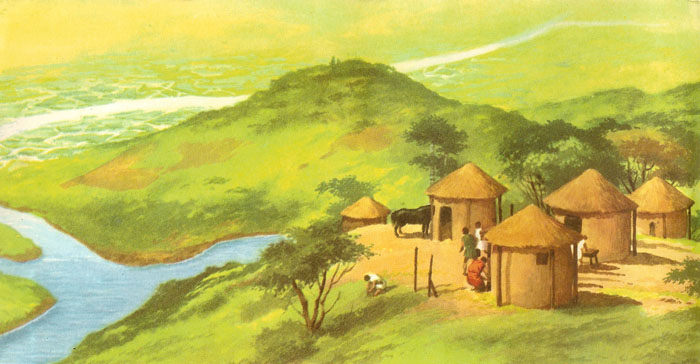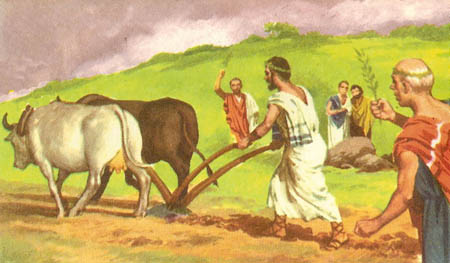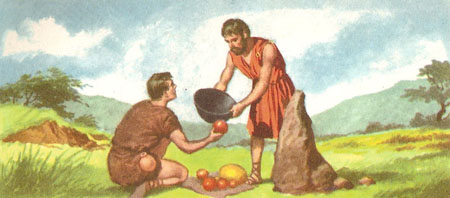Rome, early history

The people who inhabited Italy when Rome was founded.

Artist's impression of an early settlement on the Palatine Hill.

In this artist's conception, a plow is drawn to trace out the walls of the embryonic city of Rome.

A family prays for protection before the shrine of its household gods.

Two peasants exchange goods at the boundary of their fields, marked by a prominent stone.
About 2000 BC, the first people were making their way across the Alps into Italy. At first for the sake of safety they built their houses on wooden pillars in the lakes. The people who settled in northern Italy in those earliest days were called Ligurians. Those who occupied the south were called Siculi.
About 1000 BC a fresh wave of people reached Italy through the Alpine passes. They came from Asia and occupied various parts of central and southern Italy. They were the Umbrians, Sabines, Samnites, and Latins.
Two centuries later, the Etruscans, be lived to have come from Asia Minor, landed in Italy and settled in what is today Tuscany.
Latin settlement
The Latins established themselves in that part of central Italy now called the Lazio, but known in ancient Roman times as Latium.
They were shepherds and farmers and lived in huts. Each of their villages formed a little community governed by a king, and by 800 BC there were about forty such villages united in a religious federation.
At the head of this federation was the city of Albalunga on the Alban Hills. Every year the Latins went there to celebrate a great religious festival which lasted four days. Ceremonies were performed in the temple of the chief Latin god – Jupiter Latiaris.
The area which the ancient Latins called Latium consisted of a plain beside the River Tiber and along the coast, mostly malaria-ridden swamp; and hills of rich vegetation and easily cultivated soil.
At first the Latins settled in the hills. But they did not neglect the plain. Although they would be more open to attack here, they realized how important it could be for agriculture and trade, with its great river and nearness to the sea. So they began to reclaim the marshes and to control the waters of the Tiber, which overflowed at several points and flooded great areas.
But although they made the plain fertile, they went on building their villages in the hills above, for they feared the raids of Ligurians and Phoenicians, whose pirate ships continually raided the coasts and estuaries.
From the hills too they could protect themselves from their neighbors who coveted the growing wealth of Latium, its wool and its wood.
How Rome was founded on the Palatine Hill
Several times the Latins had to meet attacks from the Etruscans, attacking from the north. What the Latins needed was a bulwark across the usual line of Etruscan advance.
What would be the most suitable position? The Palatine Hill, astride the very route the Etruscans used, seemed the very place from which to obstruct the enemy's advance. Moreover, the Latins saw that this hill not only controlled the route into Etruria, but also the route across the Tiber to the sea.
So it was also a site convenient to trade; in that age the Tiber was the only important commercial route in the area. Boatloads of salt arrived by sea, eagerly awaited by the people of the interior, and loads of wool were taken down to the sea so that the Latins could trade it for the produce of other peoples. All the circumstances favored that hill above the river and only 11 miles from the sea as the site of the new village.
By tradition it was on 21 April 753 BC, that the Latins added the new village on the Palatine Hill to the many scattered villages of Latium. It was given the name of Rome, perhaps because in bygone days the Tiber had been called Rumon.
How the Latins founded their cities
The rites used by the Latins when they founded a city were not simple, and it seems that they learned them from the Etruscans. Rome was probably founded with those rites. So we can imagine the sacred ceremonial which took place about 3,000 years ago on the Palatine Hill. A group of peasants arrived on the hill where the new city was to arise. A fire of brushwood was lit and each man jumped through the fire to cleanse himself from all evil. The man chosen to be the city's founder drove a deep furrow with a plow and each man present threw into it a little earth from his own village. Now the founder put on priestly robes, harnessed a bull and cow to the plow, and guided them round the area where the walls of the city were to arise. Wherever the wall was to have a gate, the founder raised the plow, breaking the furrow for a space. The outline thus traced was sacred; neither the new citizens nor foreigners could cross it without permission from the founder. To leap over it was considered sacrilege and was punished with death.
The religion of the Latins
The Latins were deeply religious. They worshipped many gods and believed that these would help them in every moment of life. Every city, wild place, house, and hearth had its protecting god, called by the Latins genius or "giver of life." The life of a child was protected by many such genii. Luciana guided a child at birth, Cumina as she lay in her cradle, Rumina while she was breast-feeding, Potina and Edua as she ate. Ossiphagus saw to it that her bones developed well. Every family had its own protecting genii; its Lares and Penates. The Penates watched over the family and their statuettes were placed in a statue over the hearth.
The Latins had no temples, so they made their sacrifices to the gods outdoors in the woods.
Life and work of the Latins
The peasants too had their protecting god. He was called Terminus and he protected the boundaries of the fields. The boundary stones that marked the fields were called terminals and could only be set after sacrifice had been made to the god they worshipped.
The Latins had no coins or money and did their trade by barter. Peasants offered milk, cheese, vegetables, fruit, and wool in exchange for tools of metal or leather goods.
The Latins lived in rough clay huts with straw roofs. In the beginning Rome too was a little village of such huts. Its inhabitants were shepherds and peasants. Some became bakers, cobblers, or tailors in order to make the essentials of life.
